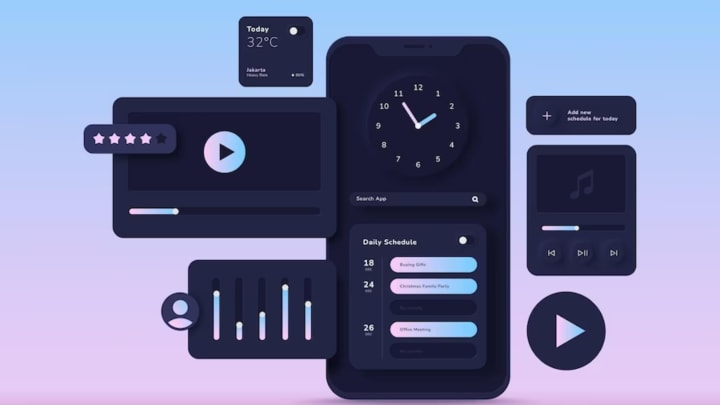Know the Benefits and Drawbacks of Flutter App Development
Explore Flutter app development's pros and cons to make informed decisions for your next project.

Flutter app development companies have recognized Flutter as the talk of the town in the world of cross-platform mobile app development. It has secured its place at the top of the list of cross-platform technologies because it allows apps to run smoothly on both iOS and Android platforms. If you're a dedicated developer who's always on the lookout for new ways to enhance your mobile app development skills, then Flutter is the technology you should be focusing on. Many organizations have taken notice of Flutter due to its impressive features.
When developers create applications for iOS and Android, they typically have to write separate code for each platform. This approach has become expensive and time-consuming for both developers and business owners. Consequently, working with a Flutter app development company can help streamline the process and reduce costs for business owners.
Is Flutter a Cross-Platform App Framework? - Let's Explore
Besides Flutter, various frameworks in the market allow developers to write code that works on both Android and iOS platforms. These tools are referred to as cross-platform mobile app development frameworks. You can even hire Flutter developers from a mobile app development company.
Among all the cross-platform tools like Phonegap, Xamarin, and React Native, Flutter has gained a strong reputation among developers, entrepreneurs, and users. It's an open-source platform used to create cross-platform mobile applications using a single source code.
In summary, Flutter is a developer-friendly programming language because it requires less code to build an application. However, while mobile app development with Flutter appears easy and reliable, it comes with its own set of advantages and disadvantages.
In this article, we will provide a detailed explanation of Flutter app development, highlighting its strengths and weaknesses. But first, let's get a clear understanding of what Flutter is.
What exactly is Flutter?
Google introduced Flutter in May 2017 as an open-source and free technology for crafting native Android and iOS apps using a single codebase. Flutter relies on the Dart programming language and adopts the React Programming Architecture. It seamlessly integrates with Android Studio, Firebase APIs, supports inline videos and ads, and empowers developers to create high-performance applications. It serves as an SDK tailored for touchscreen devices, ensuring compatibility with both iOS and Android platforms.
Unlike a framework, Flutter is a comprehensive Software Development Kit (SDK) that comes fully equipped with all the essentials for building cross-platform applications. This inclusive package encompasses a rendering engine, pre-built widgets, testing and integration APIs, as well as command-line tools.
With its diverse array of features and advantages, Flutter app development services has emerged as one of Google's most popular software offerings. Like any technology, Flutter possesses its own set of strengths and weaknesses.
Benefits of Using Flutter App Development Services
1. Hot Reload
The most exciting aspect of Hot Reload is that it allows developers and designers to instantly see all the changes and enhancements made to the code within the app. This feature strengthens the collaboration between developers and designers as they work together to improve the app's appearance and immediately assess the effects of their changes.
2. High Performance
Many factors influence an app's performance, such as CPU usage, frames per second, request rate, and average response time. When we talk about frames per second, we're referring to how smoothly and clearly an app's visuals are displayed on modern screens.
At a frame rate of 60fps, the human eye can easily spot any delays or lags. If we compare this performance to that of React Native and Xamarin, Flutter stands out with its impressive 220-millisecond launch time and a smooth 58fps frame rate.
3. Immediate Updates
Flutter provides a handy feature called hot reload. This feature lets you instantly see updates without needing any additional plugins. Not only can you see updates in real-time, but if you encounter an error while running your code, Flutter allows you to fix it right away, without the hassle of restarting.
Hot reload is a game-changer for productivity. It enables you to experiment without waiting for long delays, making the process of iteration much faster and smoother.
4. Custom Widgets for Quick UI Coding

Flutter offers a variety of pre-designed and customizable widgets to help you create a polished app interface with a consistent look and feel. Unlike some other approaches that involve different components like controllers, views, and layouts, Flutter uses a unified and consistent object model. In this framework, every element, whether it's a font, color scheme, menu, button, or padding, is considered a widget.
One of the strengths of Flutter is its flexibility in using these widgets to build layouts at any level of customization. This means you can combine widgets to create interfaces that suit your specific needs. Additionally, Flutter's widgets are known for their consistency and extensive capabilities, making it a powerful choice for app development.
5. Mild Learning Curve
Learning the Dart programming language is a breeze. Even developers with limited coding experience can quickly create prototypes and apps using this framework. Your prior experience in mobile app development won't be a significant factor in picking up Dart.
6. Cross-Platform Rendering Engine
Flutter possesses a powerful rendering engine that ensures your app performs exceptionally well across different platforms while preserving the integrity of your UI. It leverages Skia for rendering, providing a top-notch level of integration that allows your users to effortlessly access and navigate your app on any platform.
You can discover a wealth of video tutorials, documentation, beginner's guides, and hands-on lessons available online to help you master Flutter.
Also Read - Flutter: Your Ideal Pick for Launching a Mobile App Startup
Drawbacks of Flutter App Development Services
1. Large File Sizes
One significant drawback we can't overlook involves the large file sizes of apps created using Flutter. In some instances, these bulky file sizes might pose a considerable problem, leading developers to opt for alternative development tools. It's essential to realize that not everyone around the world has access to ample phone storage space. Many older devices simply can't accommodate additional apps without forcing users to make tough choices between apps and their cherished photos or music.
However, it's crucial to note that these substantial file sizes come with a trade-off – they contribute to enhanced runtime and performance. This makes it important to carefully consider the target audience you're trying to reach with your app.
2. Lack of Third-party Libraries
Third-party libraries and packages play a vital role in software development by providing developers with additional features. These libraries are typically free, open-source, well-tested, and readily accessible. However, it's important to note that you may not always find every feature you need for your current development project.
In the case of Flutter, which is relatively new to mobile app development, it can be challenging to locate free packages and libraries. Flutter is still in its growth phase and continues to improve. Consequently, you may need to exercise patience while waiting for this tool to become more robust or consider exploring alternative options for long-term development.
3. Issues with iOS
Google develops Flutter, which has developers concerned about its iOS implementation. Google's direct interest in quickly resolving bugs makes building Android apps with Flutter a fast and enjoyable experience.
Flutter recently received an update that ensures a pixel-perfect appearance on iOS devices. To achieve this, the framework introduced support for Cupertino widgets, initially designed to mimic iPhone settings. Over time, these features have been refined and adapted to match the iOS 10 and iOS 11 aesthetics, providing a polished user experience.
4. Dart
Flutter employs the Dart programming language, which comes with its own set of advantages and disadvantages. However, it's worth noting that Dart, an object-oriented programming language, may not be as widely favored as languages such as C#, Java, Objective C, or JavaScript.
For newcomers to app development, Dart can pose a steeper learning curve. Therefore, it's a crucial consideration when embarking on the development of a cross-platform application.
Is Flutter a good choice for development?
After evaluating its advantages and disadvantages, we've concluded that Flutter offers many more pros than cons for business and mobile app development services teams. You can surely build beautiful, high-performance, and amazing cross-platform mobile applications that fit your custom needs and requirements. It's worth considering Flutter, especially if you want to develop a mobile app for both iOS and Android because it is more cost-effective to hire a Flutter developer than to hire two native app developers (one for Android and one for iOS).
About the Creator
Prisha Shah
SEO Executive at Infotop Solutions






Comments
There are no comments for this story
Be the first to respond and start the conversation.